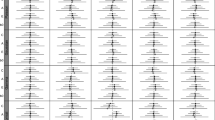Abstract
For familial aggregation of a binary trait, one method that has been used is the GEE2 (generalized estimating equation) method corresponding to a multivariate logit model. We solve the complex estimating equations for the GEE2 method using an automatic differentiation software which computes the derivatives of a function numerically using the chain rule of the calculus repeatedly on the elementary operations of the function. Based on this, we are able to show in a simulation study that the GEE2 estimates are quite close to the maximum likelihood estimates assuming a multivariate logit model, and that the GEE2 method is computationally faster when the dimension or family size is larger than four.

Similar content being viewed by others
References
Ashford, J. R. & Sowden, R. R. (1970), ‘Multivariate probit analysis’,Biometrics 26, 535–546.
Bendtsen, C. & Stauning, O. (1996), FADBAD, a flexible C++ package for automatic differentiation,Technical Report IMM-REP-1996-17, Department of Mathematical Modelling, Technical University of Denmark, DK-2800, Lyngby-Denmark.
Bischof, C. H., Roh, L. & Mauer, A. (1997), ‘ADIC – an extensible automatic differentiation tool for ANSI-C’,Software-Practice and Experience 27, 1427–1456.
Falconer, D. S. (1989),Introduction to Quantitative Genetics, 3rd edn, Longman Group, HK.
Glonek, G. F. V. & McCullagh, P. (1995), ‘Multivariate logistic models’,Journal of the Royal Statistical Society, Series B 57, 533–546.
Godambe, V. P., ed. (1991),Estimating Functions, Oxford University Press Oxford.
Griessa, R. & Walther, A. (2003), ‘Parametric sensitivities for optimal control problems using automatic differentiation’,Optimal Control Applications and Methods 24, 297–314.
Joe, H. (1997),Multivariate Models and Dependence Concepts, Chapman & Hall, London.
Johnson, N. L. & Kotz, S. (1970),Distributions in Statistics: Continuous Univariate Distributions - 2, Wiley, New York.
Latif, A. H. M. M. (2001), A comparison of methods for multivariate familial binary response, M.Sc. Thesis, Department of Statistics, University of British Columbia, Vancouver, BC, Canada.
Liang, K. Y. & Beaty, T. H. (1991), ‘Measuring familial aggregation by using oddsratio regression models’,Genetic Epidemiology 8, 361–370.
Liang, K. Y., Zeger, S. L. & Qaqish, B. (1992), ‘Multivariate regression analyses for categorical data’,Journal of the Royal Statistical Society, Series B 54, 3–24.
Mendell, N. R. & Elston, R. C. (1974), ‘Multifactorial qualitative traits: genetic analysis and prediction of recurrence risks’,Biometrics 30, 41–57.
Molenberghs, G. & Lesaffre, E. (1994), ‘Marginal modelling of correlated ordinal data using a multivariate plackett distribution’,Journal of the American Statistical Association 89, 633–644.
Nash, J. C. (1990),Compact Numerical Methods for Computers: Linear Algebra and Function Minimisation, second edn, Hilger, New York.
Szudek, J., Joe, H. & Friedman, J. M. (2002), ‘Analysis of intra-familial phenotypic variation in neurofibromatosis 1 (Nf1)’,Genetic Epidemiology 23, 150–164.
Utke, J. (2004), OpenAD: Algorithm Implementation User Guide, Technical Report No 274, Mathematics and Computer Science Division, Argonne National Laboratory.
Acknowledgements
This research is supported from an NSERC Canada grant and US Army Medical Research grant NF990038. We are grateful to the referees for comments leading to an improved presentation.
Author information
Authors and Affiliations
Rights and permissions
About this article
Cite this article
Joe, H., Mahbub-ul Latif, A.H.M. Computations for the familial analysis of binary traits. Computational Statistics 20, 439–448 (2005). https://doi.org/10.1007/BF02741307
Published:
Issue Date:
DOI: https://doi.org/10.1007/BF02741307



